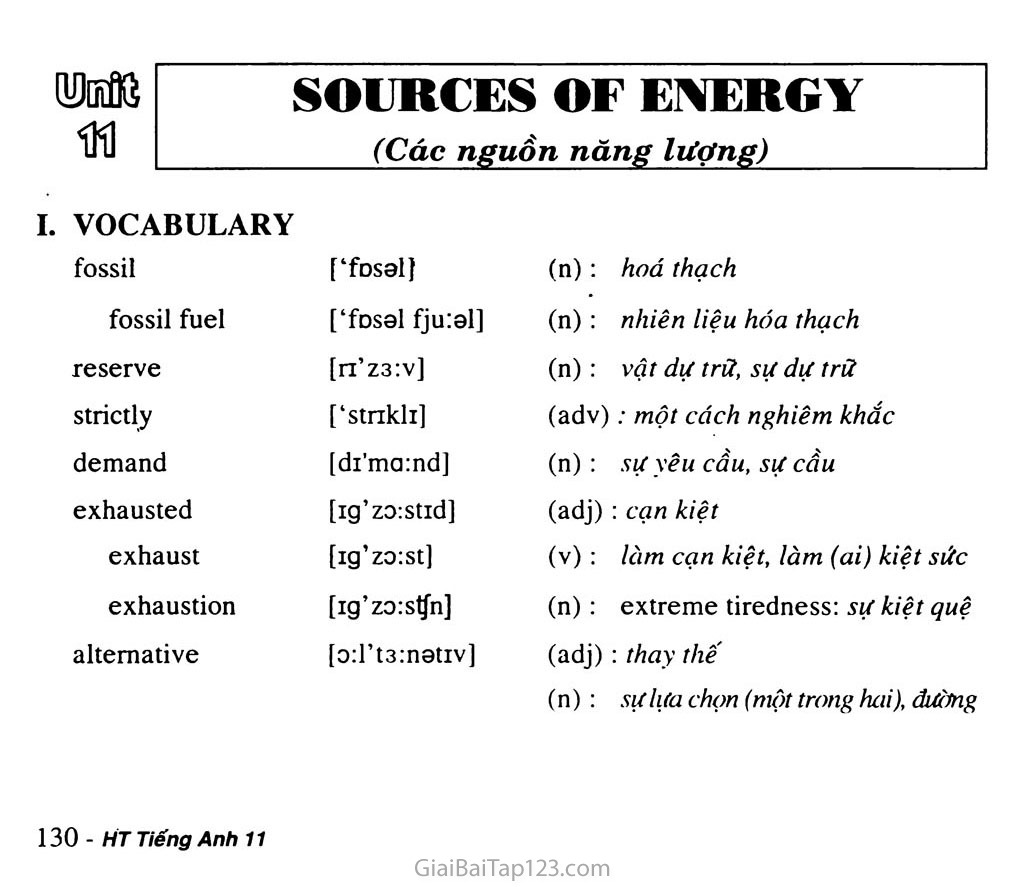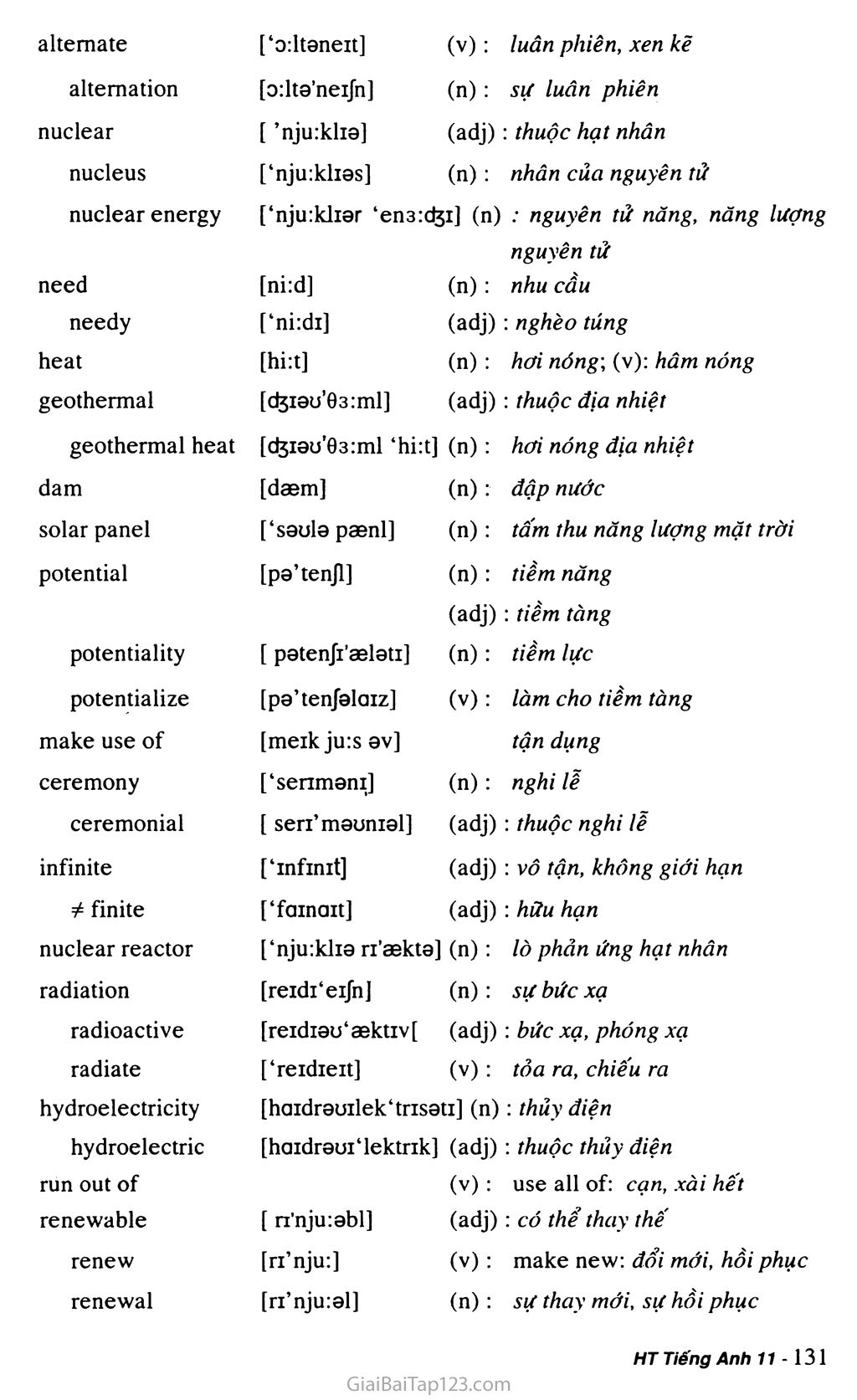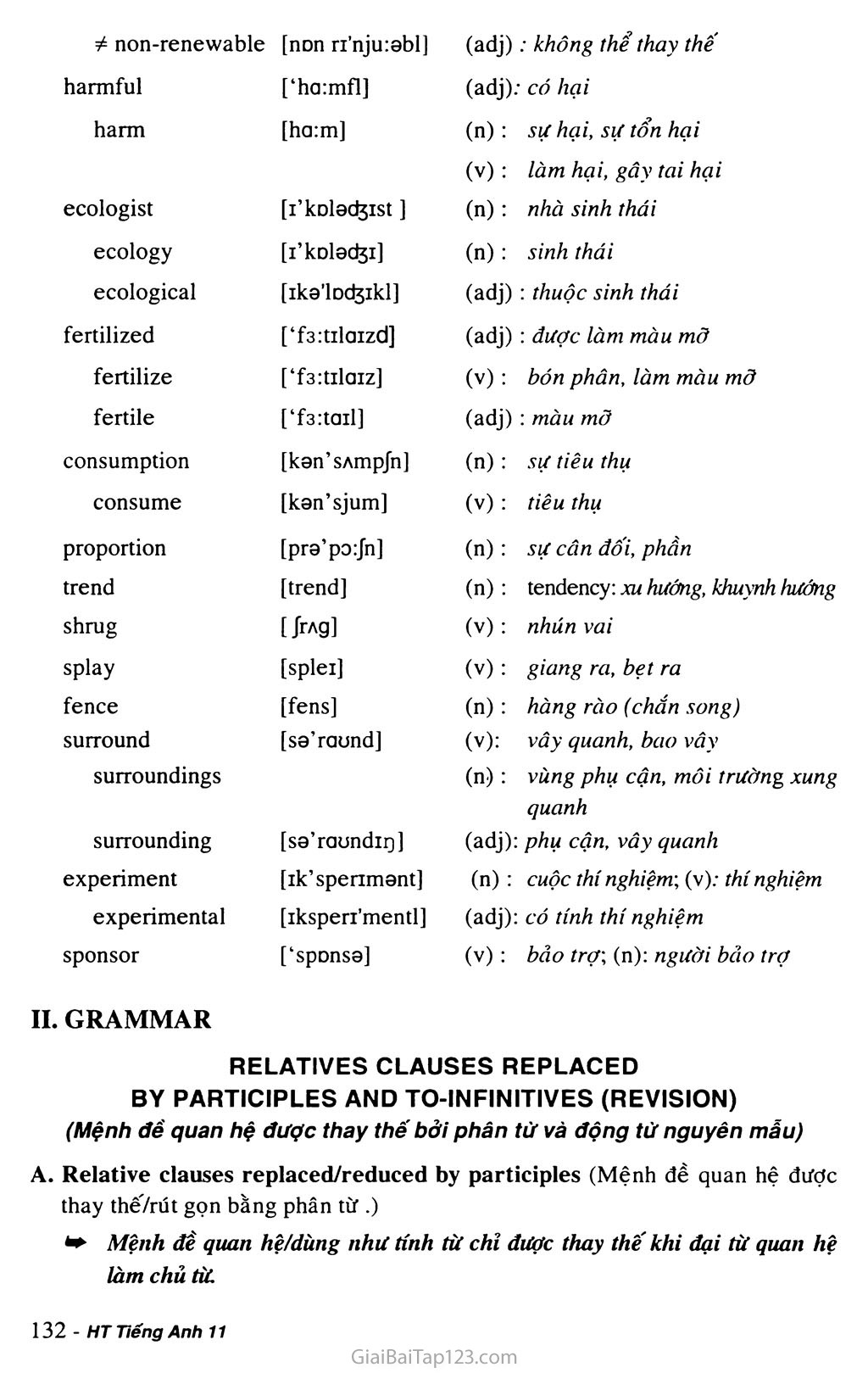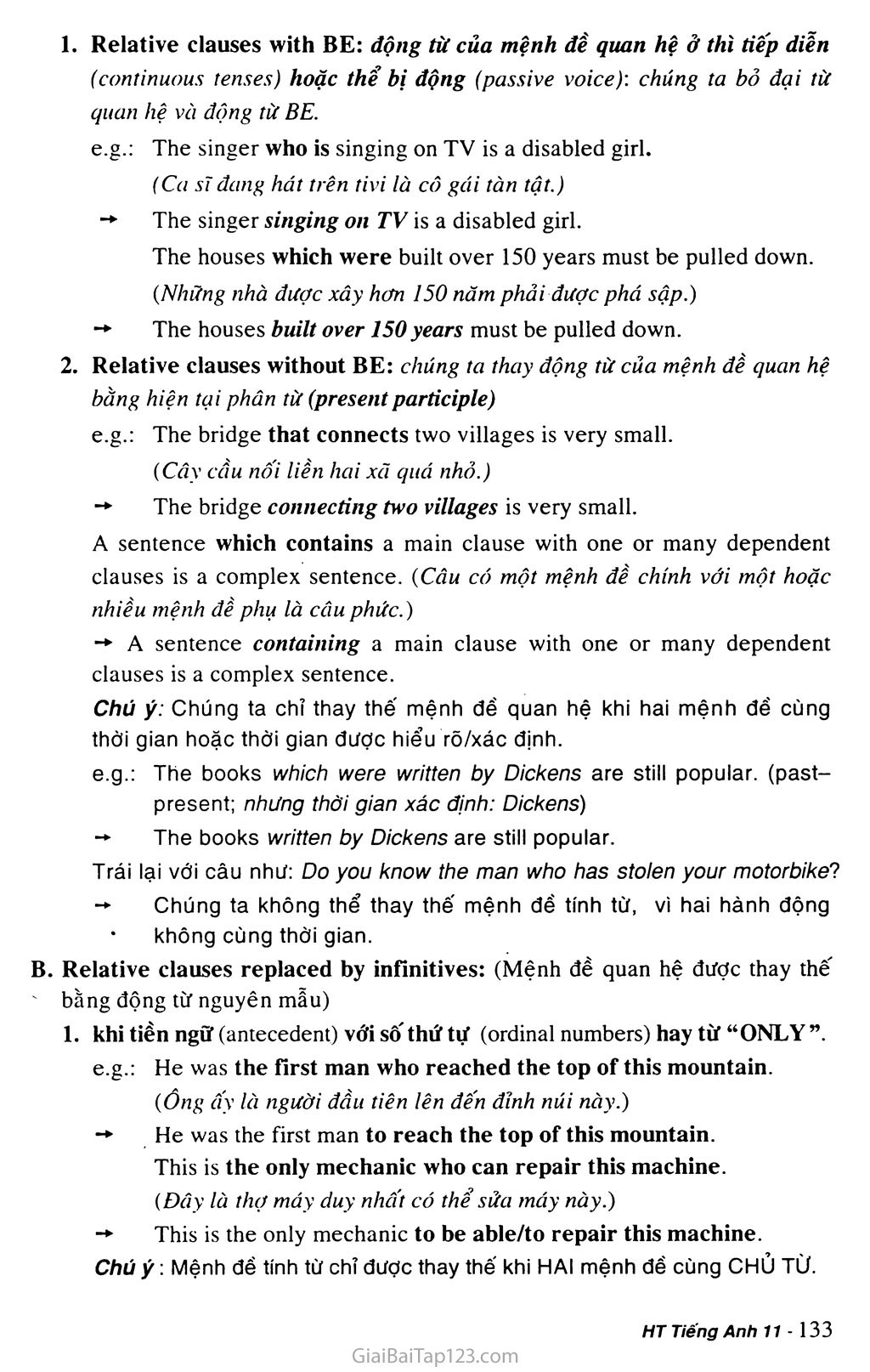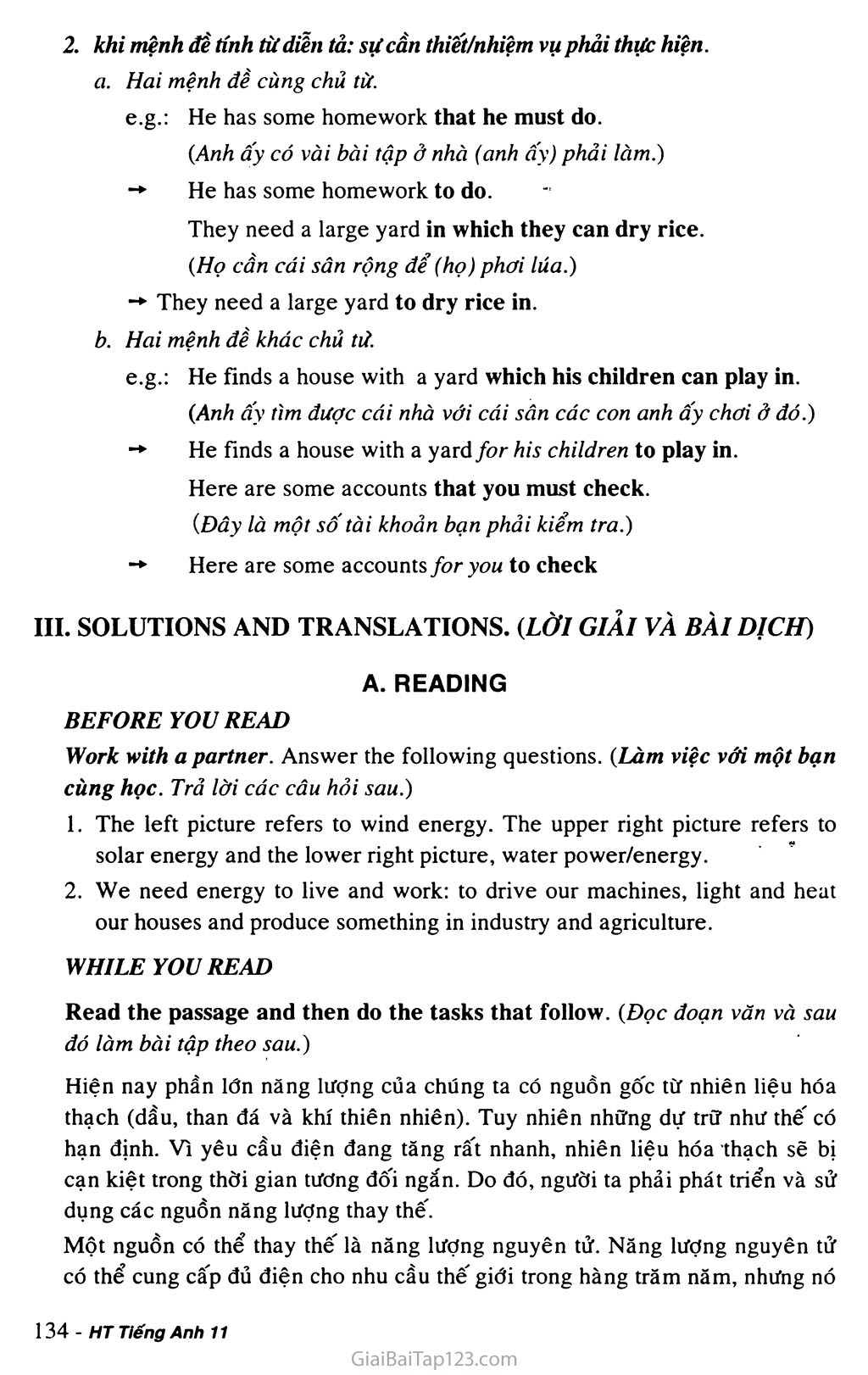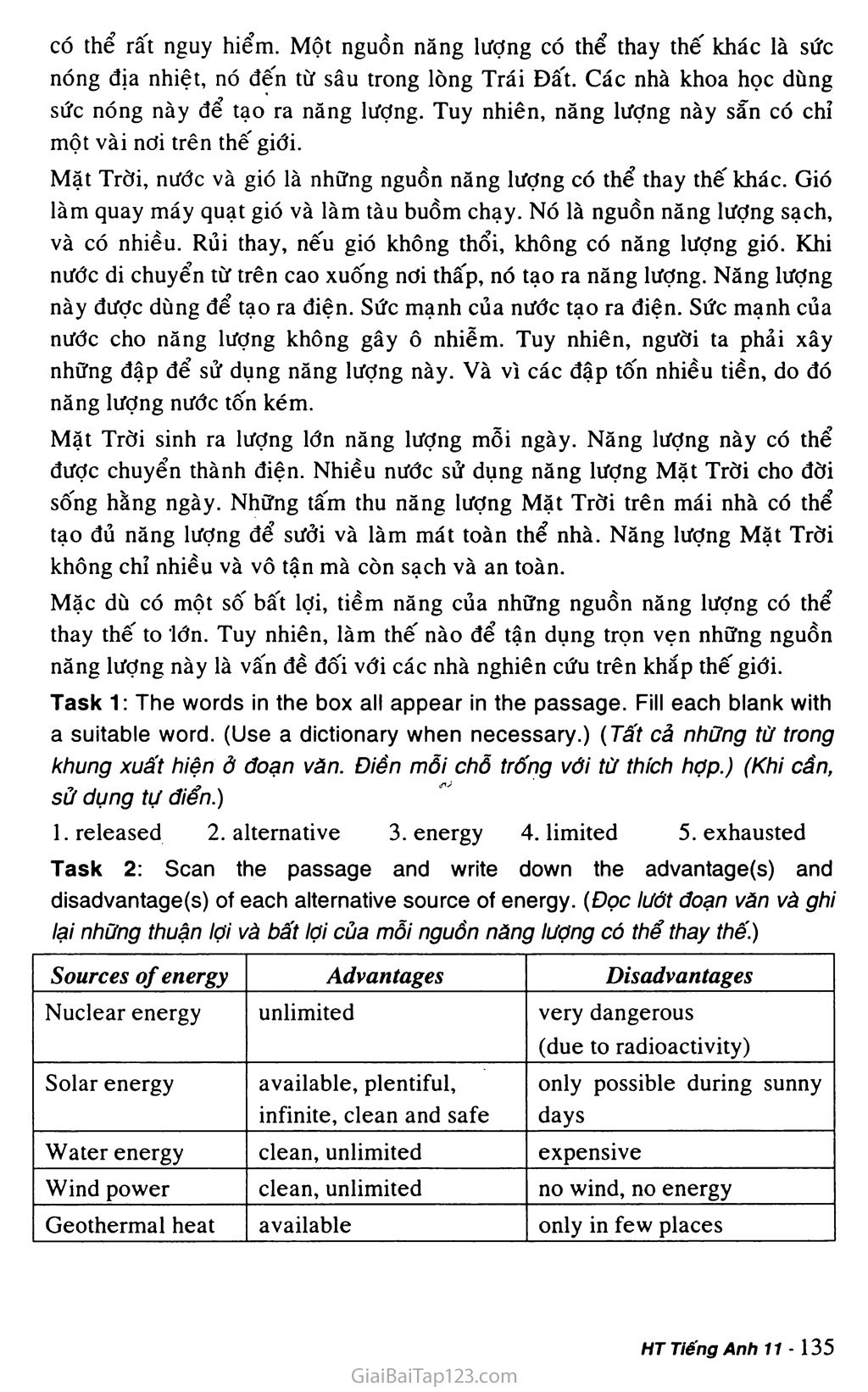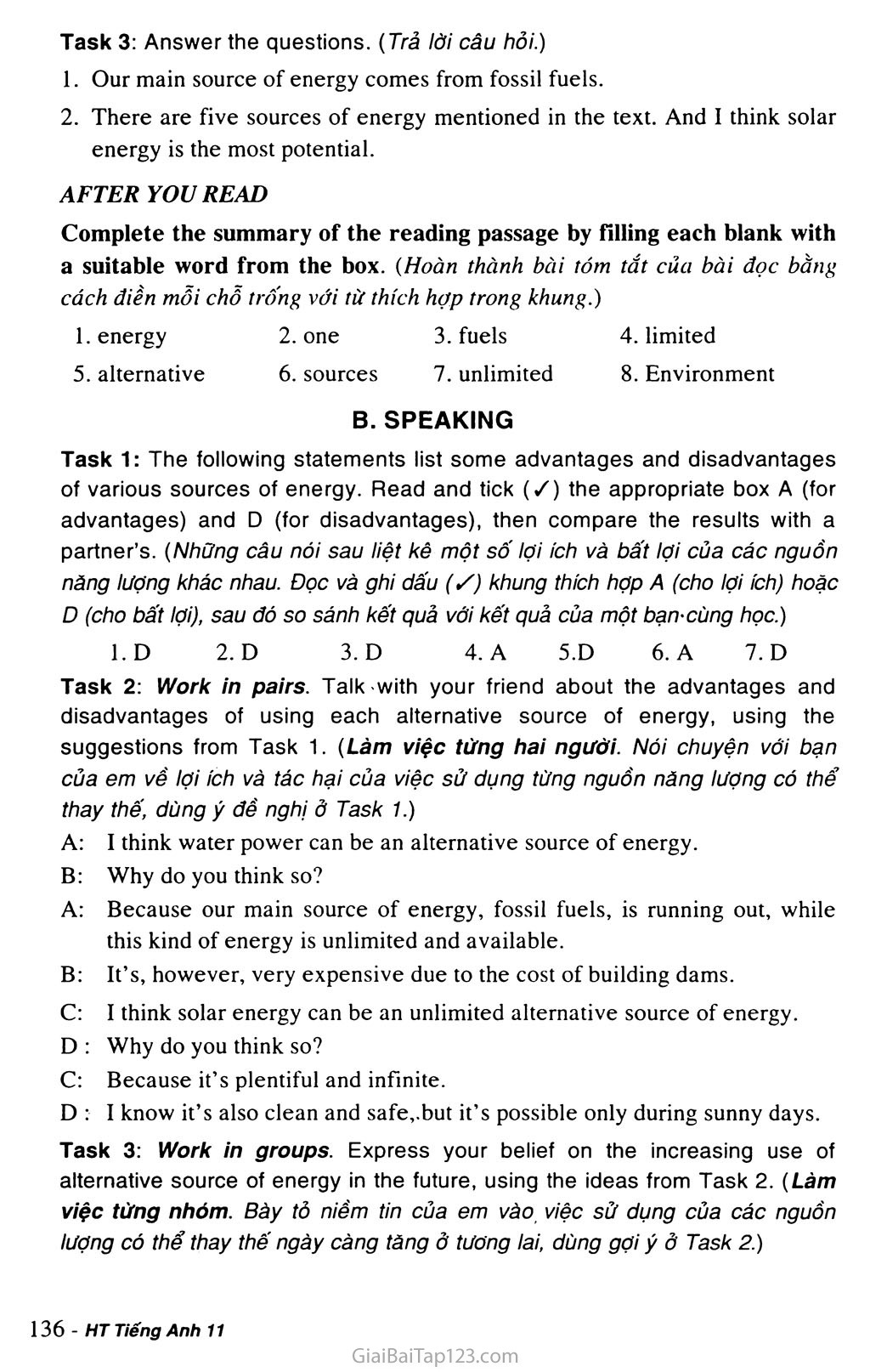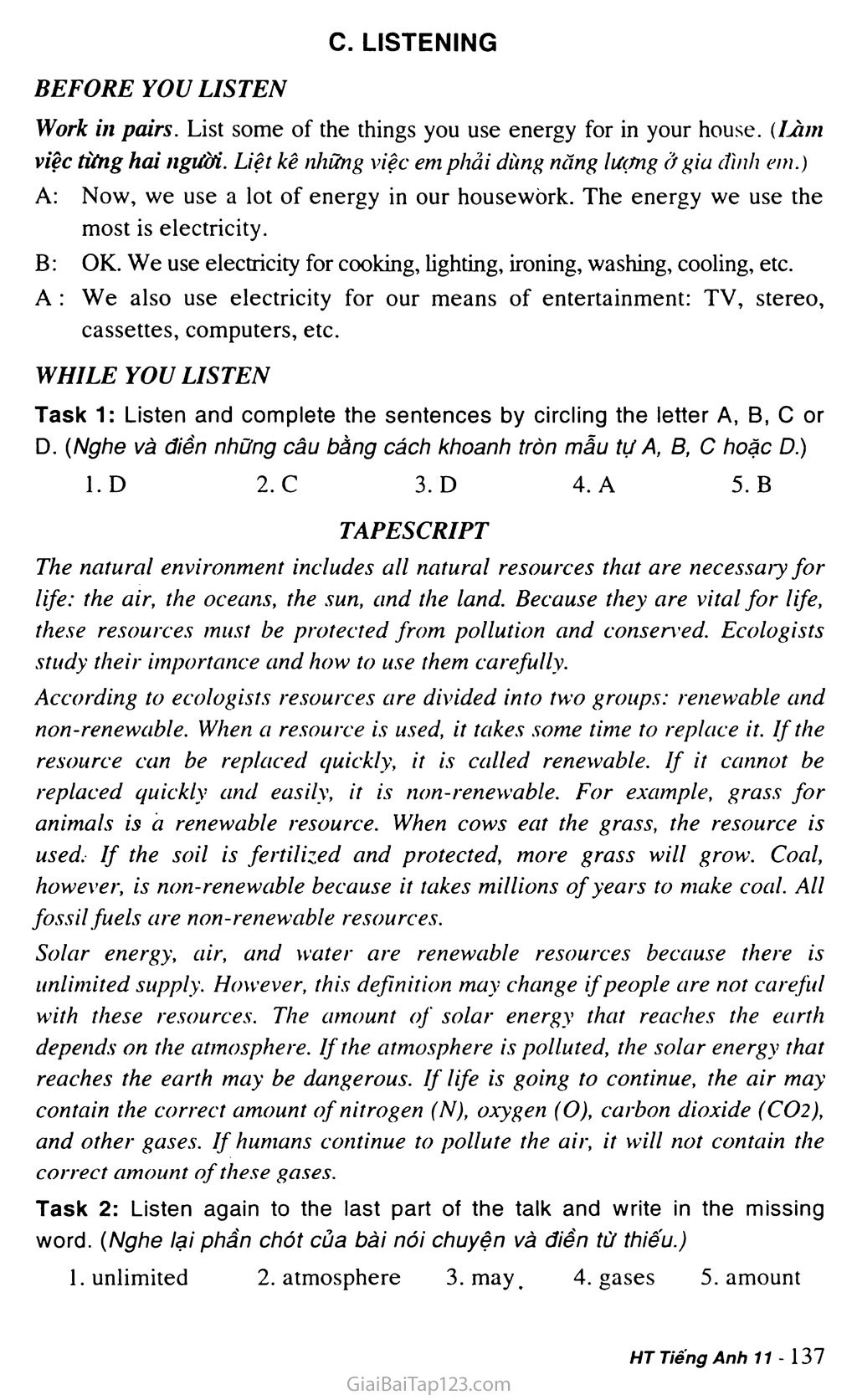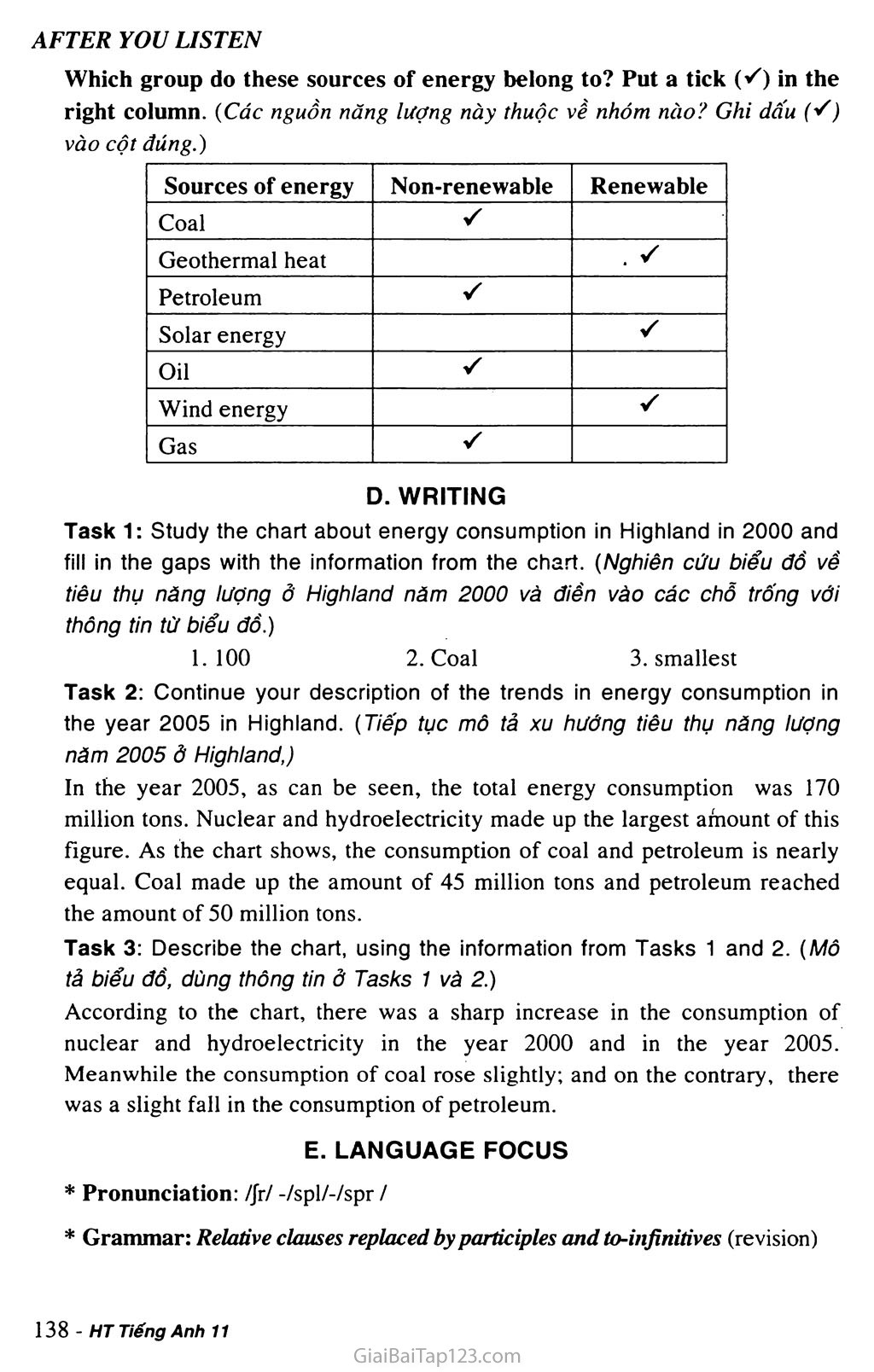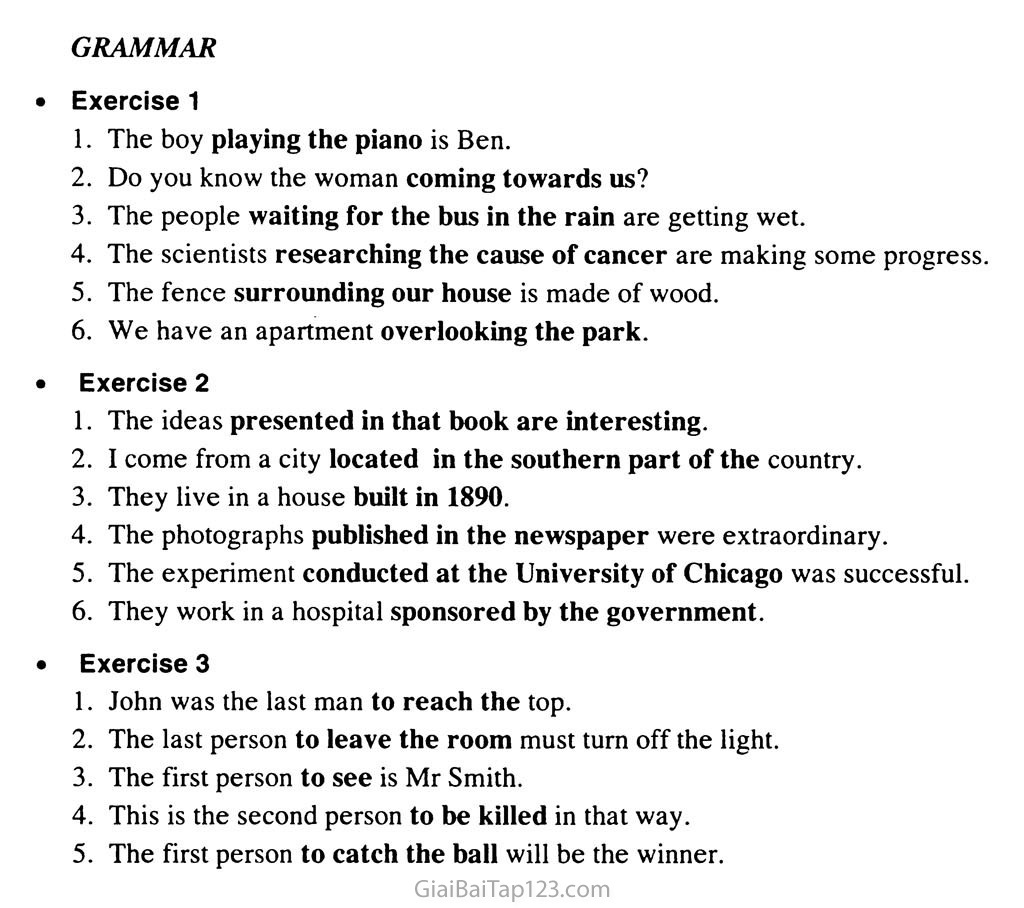Giải tiếng Anh lớp 11 Unit 11: SOURCES OF ENERGY
IMS SOURCES OF ENERGY 5M (Các nguồn năng lượng) VOCABULARY fossil [‘fDsalJ (n): hod thạch fossil fuel [TdssI fju:sl] (n): nhiên liệu hóa thạch reserve [n’z3:v] (n): vật dự trữ, sự dự trữ strictly [‘stnklil (adv) : một cách nghiêm khắc demand [dl’mamdj (n): sự yêu cầu, sự cầu exhausted [ig’zo:stid] (adj) cạn kiệt exhaust [ig’zo:st] (V): làm cạn kiệt, làm (ai) kiệt sức exhaustion [ig’zo:sựn] (n) : extreme tiredness: sự kiệt quệ alternative [o:l’t3:nativ] (adj) thay thế (n): sự lựa chọn (một trong hai), đường alternate [‘odtanext] (v): luân phiên, xen kẽ alternation [odta’nexjn] (n) : sự luân phiên nuclear [ ’nju:klia] (adj) : thuộc hạt nhân nucleus [*nju:kli9s] (n) : nhân của nguyên tử nuclear energy [‘nju:kli9r ‘en3:d3i] (n) : nguyên tử năng, năng lượng nguyên tử need [ni:d] (n) : nhu cầu needy f‘ni:di] (adj) : nghèo túng heat [hi:t] (n) : hơi nóng', (v): hâm nóng geothermal [d3i9u’03:ml] (adj) : thuộc địa nhiệt geothermal heat [d3i9u'03:ml ‘hi:t] (n): hơi nóng địa nhiệt dam [daem] (n) : đập nước solar panel [‘saơla paenl] (n) : tấm thu năng lượng mặt trời potential [pa’tenjl] (n) : tiềm năng (adj): tiềm tàng potentiality [ patenji’aslati] (n) : tiềm lực potentialize [pa’tenjalaiz] (v) : làm cho tiềm tàng make use of [meik ju:s 9v] tận dụng ceremony [‘serimani] (n) : nghi lễ ceremonial [ seri’maumal] (adj) : thuộc nghi lễ infinite [‘infinit] (adj) : vô tận, không giới hạn # finite [‘fainait] (adj) : hữu hạn nuclear reactor [*nju:kli9 ri’aekta] (n) : lò phản ứng hạt nhân radiation [reidi'eijn] (n) : sự bức xạ radioactive [reidi9ư‘aektiv[ (adj) : bức xạ, phóng xạ radiate [‘reidieit] (v) : tỏa ra, chiếu ra hydroelectricity [haidrauilek'trisati] (n): thủy điện hydroelectric [haidraui‘lektrik] (adj) : thuộc thủy điện run out of (v) : use all of: cạn, xài hết renewable [ n’njuiabl] (adj) : có thể thay thế renew [ri’nju:] (v) : make new: đổi mới, hồi phục renewal [ri’njuml] (n) : sự thay mới, sự hồi phục + non-renewable [non rinju:abl] (adj) : không thể thay thế harmful [‘ha:mfl] (adj); có hại harm [ha:m] (n) : sự hại, sự tổn hại (v) : làm hại, gây tai hại ecologist [i’kDled3ist ] (n) : nhà sinh thái ecology [I’kDladsi] (n) : sinh thái ecological [ika’lDd3ikl] (adj) : thuộc sinh thái fertilized [‘f3:tilaizd] (adj) : được làm màu mỡ fertilize [‘f3:tilaiz] (v) : bón phân, làm màu mỡ fertile [lf3:tail] (adj) : màu mỡ consumption [kan’sAmpfn] (n) : sự tiêu thụ consume [kan’sjum] (v) : tiêu thụ proportion [pra’po:Jn] (n) : sự cân đối, phần trend [trend] (n) : tendency: xu hướng, khuynh hướng shrug [JrAg] (v) : nhún vai splay [spiel] (v) : giang ra, bẹt ra fence [fens] (n) : hàng rào (chắn song) surround [sa'raund] (v); vây quanh, bao vây surroundings (n) : vùng phụ cận, môi trường xung quanh surrounding [sa’raundip] (adj): phụ cận, vây quanh experiment [ik’sperimant] (n) : cuộc thí nghiệm; (v); thí nghiệm experimental [iksperi’mentl] (adj): có tính thí nghiệm sponsor [‘spDnsa] (v) : bảo trợ; (n); người bảo trợ II. GRAMMAR RELATIVES CLAUSES REPLACED BY PARTICIPLES AND TO-INFINITIVES (REVISION) (Mệnh đề quan hệ được thay thế bởi phân từ và động từ nguyên mẫu) A. Relative clauses replaced/reduced by participles (Mệnh đề quan hệ được thay thế/rút gọn bằng phân từ .) Mệnh đề quan hệ/dùng như tính từ chỉ được thay thế khỉ đại từ quan hệ làm chủ từ. Relative clauses with BE: động từ của mệnh đề quan hệ ở thì tiếp diễn (continuous tenses) hoặc thể bị động (passive voice): chúng ta bỏ đại từ quan hệ và động từ BE. g.: The singer who is singing on TV is a disabled girl. (Ca sĩ đang hát trên tỉvi là cô gái tàn tật.) -*■ The singer singing on TV is a disabled girl. The houses which were built over 150 years must be pulled down. (Những nhà được xây hơn 150 năm phải được phá sập.) -* The houses built over 150years must be pulled down. Relative clauses without BE: chúng ta thay động từ của mệnh đề quan hệ bằng hiện tại phân từ (present participle) e.g.: The bridge that connects two villages is very small. (Cây cầu nối liền hai xã quá nhỏ.) -*■ The bridge connecting two villages is very small. A sentence which contains a main clause with one or many dependent clauses is a complex sentence. (Câu có một mệnh đề chính với một hoặc nhiều mệnh đề phụ là câu phức.) -* A sentence containing a main clause with one or many dependent clauses is a complex sentence. Chú ý: Chúng ta chỉ thay thế mệnh đề quan hệ khi hai mệnh đề cùng thời gian hoặc thời gian được hiểu rõ/xác định. e.g.: The books which were written by Dickens are still popular, (past- present; nhưng thời gian xác định: Dickens) — The books written by Dickens are still popular. Trái lại với câu như: Do you know the man who has stolen your motorbike? -* Chúng ta không thể thay thế mệnh đề tính từ, vì hai hành động không cùng thời gian. B. Relative clauses replaced by infinitives: (Mệnh đề quan hệ được thay thế bằng động từ nguyên mẫu) 1. khi tiền ngữ (antecedent) với sô" thứ tự (ordinal numbers) hay từ “ONLY ”. e.g.: He was the first man who reached the top of this mountain. (Ông ấy là người đầu tiên lên đến đỉnh núi này.) -* He was the first man to reach the top of this mountain. This is the only mechanic who can repair this machine. (Đây là thợ máy duy nhất có thể sửa máy này.) -*■ This is the only mechanic to be able/to repair this machine. Chú ý: Mệnh đề tính từ chỉ được thay thế khi HAI mệnh đề cùng CHỦ TỪ. khi mệnh đề tính từ diễn tả: sự cần thiết/nhiệm vụ phải thực hiện. Hai mệnh đề cùng chủ từ. e.g.: He has some homework that he must do. (Anh ấy có vài bài tập ở nhà (anh ấy) phải làm.) “* He has some homework to do. They need a large yard in which they can dry rice. (Họ cần cái săn rộng để (họ) phơi lúa.) -*■ They need a large yard to dry rice in. Hai mệnh đề khác chủ tứ. e.g.: He finds a house with a yard which his children can play in. (Anh ấy tìm được cái nhà với cái sân các con anh ấy chơi ở đó.) -*■ He finds a house with a yard/or his children to play in. Here are some accounts that you must check. (Đây là một số tài khoản bạn phải kiểm tra.) -* Here are some accounts for you to check III. SOLUTIONS AND TRANSLATIONS. (LỜỈ GIẢI VÀ BÀI DỊCH) A. READING BEFORE YOU READ Work with a partner. Answer the following questions. (Làm việc với một bạn cùng học. Trả lời các câu hỏi sau.) The left picture refers to wind energy. The upper right picture refers to solar energy and the lower right picture, water power/energy. We need energy to live and work: to drive our machines, light and heat our houses and produce something in industry and agriculture. WHILE YOU READ Read the passage and then do the tasks that follow. (Đọc đoạn văn và sau đó làm bài tập theo sau.) Hiện nay phần lớn năng lượng của chúng ta có nguồn gô'c từ nhiên liệu hóa thạch (dầu, than đá và khí thiên nhiên). Tuy nhiên những dự trữ như thế có hạn định. Vì yêu cầu điện đang tăng rat nhanh, nhiên liệu hóa thạch sẽ bị cạn kiệt trong thời gian tương đôi ngắn. Do đó, người ta phải phát triển và sử dụng các nguồn năng lượng thay thế. Một nguồn có thể thay thế là năng lượng nguyên tử. Năng lượng nguyên tử có thể cung cấp đủ điện cho nhu cầu thế giới trong hàng trăm năm, nhưng nó có thể rất nguy hiểm. Một nguồn năng lượng có thể thay thế khác là sức nóng địa nhiệt, nó đến từ sâu trong lòng Trái Đất. Các nhà khoa học dùng sức nóng này để tạo ra năng lượng. Tuy nhiên, năng lượng này sẵn có chỉ một vài nơi trên thế giới. Mặt Trời, nước và gió là những nguồn năng lượng có thể thay thế khác. Gió làm quay máy quạt gió và làm tàu buồm chạy. Nó là nguồn năng lượng sạch, và có nhiều. Rủi thay, nếu gió không thổi, không có năng lượng gió. Khi nước di chuyển từ trên cao xuống nơi tháp, nó tạo ra năng lượng. Năng lượng này được dùng để tạo ra điện. Sức mạnh của nước tạo ra điện. Sức mạnh của nước cho năng lượng không gây ô nhiễm. Tuy nhiên, người ta phải xây những đập để sử dụng năng lượng này. Và vì các đập tốn nhiều tiền, do đó năng lượng nước tốn kém. Mặt Trời sinh ra lượng lớn năng lượng mỗi ngày. Năng lượng này có thể được chuyển thành điện. Nhiều nước sử dụng năng lượng Mặt Trời cho đời sông hằng ngày. Những tâm thu năng lượng Mặt Trời trên mái nhà có thể tạo đủ năng lượng để sưởi và làm mát toàn thể nhà. Năng lượng Mặt Trời không chỉ nhiều và vô tận mà còn sạch và an toàn. Mặc dù có một sô" bất lợi, tiềm năng của những nguồn năng lượng có thể thay thế to 'lớn. Tuy nhiên, làm thế nào để tận dụng trọn vẹn những nguồn năng lượng này là vấn đề đôi với các nhà nghiên cứu trên khắp thế giới. Task 1: The words in the box all appear in the passage. Fill each blank with a suitable word. (Use a dictionary when necessary.) (Tất cả những từ trong khung xuất hiện ở đoạn văn. Điền mỗi chỗ trống với từ thích hợp.) (Khi cần, sử dụng tự điển.) released 2. alternative 3. energy 4. limited 5. exhausted Task 2: Scan the passage and write down the advantage(s) and disadvantage(s) of each alternative source of energy. (Đọc lướt đoạn văn và ghi lại những thuận lợi và bất lợi của mỗi nguồn năng lượng có thể thay thế.) Sources of energy Advantages Disadvantages Nuclear energy unlimited very dangerous (due to radioactivity) Solar energy available, plentiful, infinite, clean and safe only possible during sunny days Water energy clean, unlimited expensive Wind power clean, unlimited no wind, no energy Geothermal heat available only in few places Task 3: Answer the questions. (Trả lời câu hỏi.) Our main source of energy comes from fossil fuels. There are five sources of energy mentioned in the text. And I think solar energy is the most potential. AFTER YOU READ Complete the summary of the reading passage by filling each blank with a suitable word from the box. (Hoàn thành bèii tóm tắt của bài đọc bằng cách điền mỗi chỗ trông với từ thích hợp trong khung.) 1. energy 2. one 3. fuels 4. limited 5. alternative 6. sources 7. unlimited 8. Environment B. SPEAKING Task 1: The following statements list some advantages and disadvantages of various sources of energy. Read and tick (Z) the appropriate box A (for advantages) and D (for disadvantages), then compare the results with a partner’s. (Những câu nói sau liệt kê một số lợi ích và bất lợi của các nguồn năng lượng khác nhau. Đọc và ghi dấu (7) khung thích hợp A (cho lợi ích) hoặc D (cho bất lợi), sau đó so sánh kết quả với kết quả của một bạn-cùng học.) l.D 2. D 3. D 4. A 5.D 6. A 7. D Task 2: Work in pairs. Talk with your friend about the advantages and disadvantages of using each alternative source of energy, using the suggestions from Task 1. (Làm việc từng hai người. Nói chuyện với bạn của em về lợi ích và tác hại của việc sử dụng từng nguồn năng lượng có thể thay thế, dùng ý đề nghị ở Task 1.) A: I think water power can be an alternative source of energy. B: Why do you think so? A: Because our main source of energy, fossil fuels, is running out, while this kind of energy is unlimited and available. B: It’s, however, very expensive due to the cost of building dams. C: I think solar energy can be an unlimited alternative source of energy. D : Why do you think so? C: Because it’s plentiful and infinite. D : I know it’s also clean and safe,.but it’s possible only during sunny days. Task 3: Work in groups. Express your belief on the increasing use of alternative source of energy in the future, using the ideas from Task 2. (Làm việc từng nhóm. Bày tỏ niềm tin của em vào việc sử dụng của các nguồn lượng có thể thay thế ngày càng tàng ở tưong lai, dùng gợi ý ở Task 2.) LISTENING BEFORE YOU LISTEN Work in pairs. List some of the things you use energy for in your house. (IÀm việc từng hai người. Liệt kê những việc em phải dùng năng lượng ở gia dinh em.) A: Now, we use a lot of energy in our housework. The energy we use the most is electricity. B: OK. We use electricity for cooking, lighting, ironing, washing, cooling, etc. A : We also use electricity for our means of entertainment: TV, stereo, cassettes, computers, etc. WHILE YOU LISTEN Task 1: Listen and complete the sentences by circling the letter A, B, c or D. (Nghe và điền những câu bàng cách khoanh tròn mẫu tự A, B, c hoặc D.) l.D 2.C 3. D 4. A 5.B TAPESCRIPT The natural environment includes all natural resources that are necessary for life: the air, the oceans, the sun, and the land. Because they are vital for life, these resources must be protected from pollution and conserved. Ecologists study their importance and how to use them carefully. According to ecologists resources are divided into two groups: renewable and non-renewable. When a resource is used, it takes some time to replace it. If the resource can be replaced quickly, it is called renewable. If it cannot be replaced quickly and easily, it is non-renewable. For example, grass for animals is a renewable resource. When cows eat the grass, the resource is used. If the soil is fertilized and protected, more grass will grow. Coal, however, is non-renewable because it takes millions of years to make coal. All fossil fuels are non-renewable resources. Solar energy, air, and water are renewable resources because there is unlimited supply. However, this definition may change if people are not careful with these resources. The amount of solar energy that reaches the earth depends on the atmosphere. If the atmosphere is polluted, the solar energy that reaches the earth may be dangerous. If life is going to continue, the air may contain the correct amount of nitrogen (N), oxygen (O), carbon dioxide (CO2), and other gases. If humans continue to pollute the air, it will not contain the correct amount of these gases. Task 2: Listen again to the last part of the talk and write in the missing word. (Nghe lại phần chót của bài nói chuyện và điền từ thiếu.) 1. unlimited 2. atmosphere 3. may. 4. gases 5. amount AFTER YOU LISTEN Which group do these sources of energy belong to? Put a tick (Z) in the right column. (Các nguồn năng lượng này thuộc về nhóm nào? Ghi dấu (■/) vào cột đúng.) Sources of energy Non-renewable Renewable Coal z Geothermal heat . z Petroleum z Solar energy z Oil z Wind energy z Gas z D. WRITING Task 1: Study the chart about energy consumption in Highland in 2000 and fill in the gaps with the information from the chart. (Nghiên cứu biểu đồ về tiêu thụ năng lượng ở Highland năm 2000 và điền vào các chỗ trống với thông tin từ biểu đồ.) 1.100 2. Coal 3. smallest Task 2: Continue your description of the trends in energy consumption in the year 2005 in Highland. (Tiếp tục mô tả xu hướng tiêu thụ năng lượng năm 2005 ở Highland,) In the year 2005, as can be seen, the total energy consumption was 170 million tons. Nuclear and hydroelectricity made up the largest amount of this figure. As the chart shows, the consumption of coal and petroleum is nearly equal. Coal made up the amount of 45 million tons and petroleum reached the amount of 50 million tons. Task 3: Describe the chart, using the information from Tasks 1 and 2. (MÔ tả biểu đồ, dùng thông tin ở Tasks 1 và 2.) According to the chart, there was a sharp increase in the consumption of nuclear and hydroelectricity in the year 2000 and in the year 2005. Meanwhile the consumption of coal rose slightly; and on the contrary, there was a slight fall in the consumption of petroleum. E. LANGUAGE FOCUS Pronunciation: /Jr/ -/spl/-/spr / Grammar: Relative clauses replaced by participles and to-infinitives (revision) GRAMMAR Exercise 1 The boy playing the piano is Ben. Do you know the woman coming towards US? The people waiting for the bus in the rain are getting wet. The scientists researching the cause of cancer are making some progress. The fence surrounding our house is made of wood. We have an apartment overlooking the park. Exercise 2 The ideas presented in that book are interesting. I come from a city located in the southern part of the country. They live in a house built in 1890. The photographs published in the newspaper were extraordinary. The experiment conducted at the University of Chicago was successful. They work in a hospital sponsored by the government. Exercise 3 John was the last man to reach the top. The last person to leave the room must turn off the light. The first person to see is Mr Smith. This is the second person to be killed in that way. The first person to catch the ball will be the winner.

